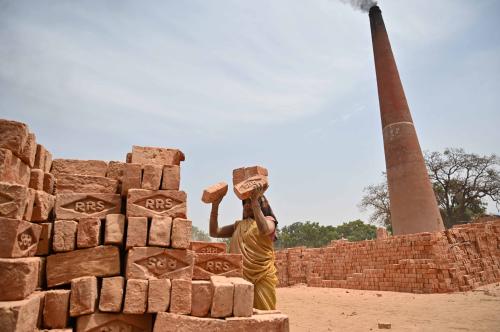Global action on climate change has been slow. In 2015, signatories to the Paris Agreement decided to limit temperature rises to less than 2 degrees Celsius above preindustrial levels by bringing emissions to net zero by the second half of the century. In February 2021, an initial assessment covering 40 percent of the signatories to the agreement has shown little progress.
With voluntary actions stalling, in July 2021, the European Union (EU) proposed a comprehensive plan to boost climate change mitigation efforts. The plan includes a Carbon Border Adjustment Mechanism (CBAM), which aims to equalize the fees on the carbon content of goods in the EU regardless of where they were produced by imposing carbon border taxes. The proposal initially covers cement, iron and steel, aluminum, fertilizers, and electricity; any carbon fees already paid at the source will be deducted.
The proposed CBAM could help alleviate “leakage.” When emissions are restricted in the home country, for example by cap-and-trade mechanisms, firms can relocate production to other countries to avoid restrictions—giving rise to pollution havens. Consumers in the home country can then buy cheaper, carbon-tax-free imports rather than the more expensive domestic alternatives. The fact that most high-income countries have become net importers of CO2 while most developing economies are net exporters indicates that leakage is a serious problem. Carbon border taxes can suppress this effect by effectively equalizing carbon prices for domestic and foreign producers in the home market.
Effects on emissions in developing countries
Although developing countries may gain significantly from global mitigation efforts in the long run, given their greater exposure to climate risks, in the short run they may have little incentive to undertake costly emission reductions. Can the CBAM incentivize them to comply? To answer this question, we use a simple hypothetical example (Figure 1), adopted from Mattoo et.al. (2012).
We consider a world with two economies: an advanced one (identified with *) and a developing one. Without carbon pricing, each country produces until the marginal value of its good drops to zero (the price of emissions). Thus, in the initial equilibrium, the advanced country emits O* E0, the developing country emits OE0, and the total value of production by the advanced and developing countries are respectively given by the triangles A* O* E0 and AOE0.
Figure 1. Carbon price: Compliance vs. noncompliance
 Notes: Solid lines show the value of the marginal product of emissions in advanced (black) and developing (blue) economies. The areas under the curves show the total value of production.
Notes: Solid lines show the value of the marginal product of emissions in advanced (black) and developing (blue) economies. The areas under the curves show the total value of production.
Source: Authors.
Suppose the advanced country imposes a carbon price, p*1, which reduces its emissions to O* E*1 and output to the trapezoid A* O* E*1 C*. The developing country has a choice: either comply and implement the same carbon price domestically or face a tariff at the border that is equivalent to p*1. In the case of a domestic carbon price, the developing country’s emissions decline to OE1 and its output shrinks to the trapezoid AOE1C. If it faces a border tariff, emissions reduce to OE2 and its output to the triangle BOE2. Importantly, unless the advanced country has complete market power, the price of the developing country good would drop by an amount (p2), which is smaller than the emissions tariff (p1).
Which policy would the developing country prefer? That depends on a comparison of the area of the triangle (BOE2) and that of the trapezoid (AOE1C), which cannot be done without data. Compliance is more likely when the developing country is less carbon intensive (larger A), the carbon price is lower (smaller p*1, and/or the developing country absorbs a larger share of the tariff burden (higher p2), as in the case of a small commodity exporter selling an undifferentiated product.
In this single-sector example, border taxes reduce emissions in the developing country in both cases, and especially in compliance through a scale effect. There are, however, other forces at play. If exports are more carbon intensive than other sectors in the developing country, then CBAM can shift resources to cleaner sectors, further reducing emissions through a composition effect. If exports are less carbon intensive than other sectors, carbon prices can shift resources toward more polluting sectors, leading to an increase in emissions. Finally, a lower level of trade with advanced economies may reduce access to cleaner technologies, slowing down the transition out of dirty industries. Overall, the net impact on emissions will vary across countries.
Ethics and politics
For some countries pricing the carbon domestically, and avoiding the border taxes, may be the least costly option. This, however, can prompt objections on ethical or political grounds.
The bulk of total greenhouse gas (GHG) emissions to date was produced by advanced economies. Yet, as illustrated in the example above, with less efficient economies (A<A*), a common carbon price is likely to burden developing economies more than advanced economies. Moreover, developing country constituents may also be less willing to pay for climate. Some research suggests that better environment and climate may be luxury goods—that is, the willingness to pay for them is considerably lower at low-income levels. If true, developing countries may face greater political resistance against carbon emission regulations.
These concerns can be reduced by a more nuanced and targeted implementation of carbon pricing and border taxes. But finding and implementing the “right” carbon price differentiated by country, product, and industry is a notoriously difficult task. When a Ford is made in the United States, only 40 percent of its parts are produced in the USA or Canada. The rest come from different countries around the world. Identifying the country of origin for millions of parts, and then verifying the true carbon content in each stage of processing, is a massive undertaking.
Complementary policies for border taxes
Transfers from advanced to developing countries can help distribute more equitably the burden of carbon border taxes across countries. However, with weak institutional structures in many developing countries, simply putting more cash transfers and nothing else on the table is unlikely to ensure positive economic and climate outcomes. The solution lies in aligning trade, climate, and domestic policies. This is a difficult task, but the following steps can help.
- Make the CBAM “protection-neutral” for developing countries. Border taxes should focus on making carbon emissions more costly by changing relative prices and should not be used for erecting protectionist barriers. This can be achieved by an equivalent reduction in other (tariff or nontariff) trade barriers, especially for cleaner sectors, products, or firms.
- Make clean technologies more accessible for developing countries. Some suggest that technological innovations have done more to lift people out of destitution than development aid. Cell phones in Africa, mobile payment systems in Kenya, and solar panels in Yemen have shown that, with the right conditions, leapfrogging to cleaner technologies is possible. The CBAM can promote technology transfers in the “right” industries by changing relative prices in favor of cleaner technologies. Targeted technology transfer programs can go a long way toward strengthening this effect and complementing more conventional aid mechanisms.
- Use all leverage to align domestic policies. Coordination failures among countries can lead to a “race to the bottom.” Energy subsidies give domestic producers a cost advantage that encourages the production of energy-intensive manufacturing. By contrast, in Latin America manufacturing producers are at a disadvantage due to expensive electricity despite the abundance of clean and cheap energy sources such as hydropower; the high price of electricity reflects inefficiencies in the domestic electricity distribution networks. The CBAM can help reduce such coordination failures by changing relative prices, but more needs to be done to eliminate domestic distortions, especially if too many countries remain noncompliant.
The proposed CBAM is a welcome game changer that can help boost climate change mitigation. To make it transformative, rather than punitive, and to avoid a bi-polar world with the rich and green countries and the poor and polluting ones trading primarily among themselves, more effort is needed to design a CBAM that works for all countries.
The Brookings Institution is committed to quality, independence, and impact.
We are supported by a diverse array of funders. In line with our values and policies, each Brookings publication represents the sole views of its author(s).









Commentary
Carbon border taxes: What are their implications for developing countries?
October 5, 2021